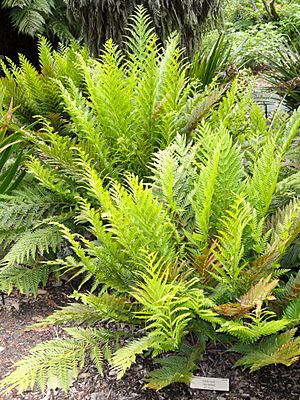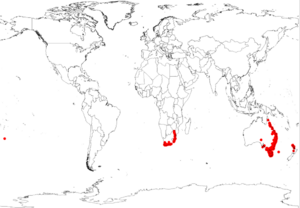Todea barbara facts for kids
Quick facts for kids King fern |
|
|---|---|
 |
|
| Scientific classification | |
| Genus: |
Todea
|
| Species: |
barbara
|
 |
|
| Occurrence data from GBIF | |
| Synonyms | |
|
Todea rivularis Kunze |
|
The King fern (Todea barbara) is a really cool plant! It's a type of fern that loves wet places. You can find it growing in parts of southeastern Australia, and it also lives in New Zealand and South Africa. It's known for being quite large and impressive.
Contents
Who Named the King Fern?
The King fern has an interesting history with its name. A famous scientist named Carl Linnaeus first described this fern in 1753. He called it Acrostichum barbarum. This was in his important book, Species Plantarum.
Later, in 1857, another botanist named Thomas Moore gave it the name we use today: Todea barbara.
What Does the King Fern Look Like?
The King fern can grow very tall! It can reach up to 3 meters (about 10 feet) in height. Even though it's tall, its main stem, called a base, is quite short and thick.
Its leaves, which are called fronds, can be super long. They can grow up to 2.5 meters (about 8 feet) in length. Imagine a fern taller than you are!
Where Does the King Fern Live?
King ferns love wet and shady spots. You can often find them growing:
- Next to streams
- In rainforest gullies
- In other damp areas within tall, open forests
Sometimes, they can even grow in drier places. This happens when they find a cozy spot in rock cracks, like on sandstone or granite cliffs.
King Ferns in South Australia
In South Australia, the King fern is becoming quite rare. Only small groups of these ferns are left in a few different places in the Mount Lofty Ranges.
One of the largest groups used to be in a place called Uraidla. Sadly, in the 1970s, some of the very old, tall fern stems were removed. This made the ferns even rarer. Luckily, some local plant experts are now growing new King ferns from spores. These new plants can be grown in gardens or planted along creek edges to help them grow back.
King Ferns in New Zealand
In New Zealand, the King fern is only found in a region called Northland. You can see them from North Cape down to Whangarei and Kai Iwi Lakes. They also live on the Three Kings Islands.
Growing King Ferns in Gardens
Many King ferns are now grown by people in the native plant industry in Australia. They grow them from spores, which are like tiny seeds for ferns.
You can often buy King ferns at plant nurseries. They make great garden plants because they look so beautiful. Most of the ferns you buy will come from areas like Victoria or New South Wales in Australia.
King ferns grow well in gardens if the climate is mild or warm. They like a spot with moist, slightly acidic soil. They prefer shade or dappled sunlight, but they can grow in sunnier spots if they get lots of water.
Images for kids



